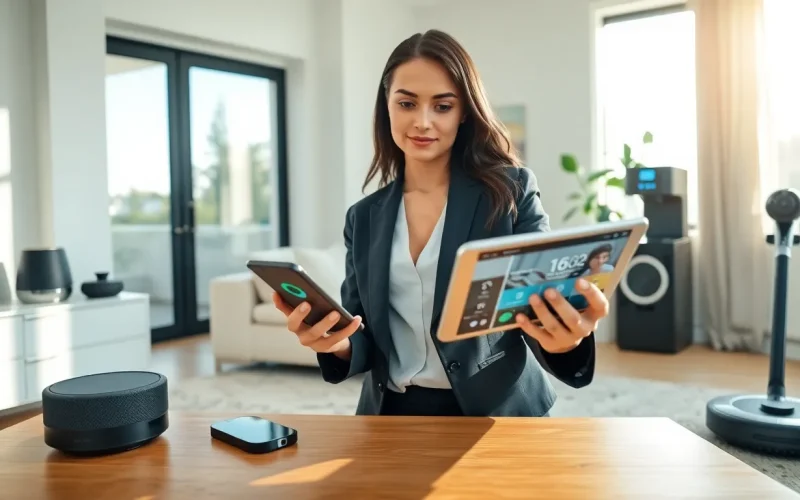Table of Contents
TogglePicture this: You wake up, and the first thing you do is check your smartphone, an extension of your hand at this point. With a few taps, you’ve already interacted with friends, scheduled appointments, and even ordered breakfast. Technology in our daily life is like that ever-present friend who’s usually got your back, although it occasionally overshares your memes and weird cat videos. From communication and education to healthcare and home automation, technology is woven into the very fabric of our existence. Let’s jump into this digital ocean and explore how these innovations are transforming our lives, while also keeping a keen eye on the challenges they bring along for the ride.
The Role Of Technology In Communication

With a few swipes of a finger, people are connecting across the globe in ways previous generations could hardly fathom. Impact Of Social Media has turned social interaction into an online spectacle. Platforms like Facebook, Twitter, and Instagram have changed how news spreads, how friendships are formed, and even how businesses engage with customers. There’s something almost magical about sharing a moment of laughter with someone across the world, all thanks to a trending meme that’s gone viral in a heartbeat.
But hold your horses. It’s not all smooth sailing in the realm of social media. The instantaneous nature of these platforms means that misinformation can spread just as quickly as that adorable puppy video. Nevertheless, the ability to connect with like-minded individuals or rekindle old friendships is a potent benefit that outweighs many downsides.
Now, let’s talk about Instant Messaging And Video Calls. Who could imagine a time when FaceTime or WhatsApp would be the norm? With real-time text, voice, and video capabilities, the world feels smaller. Whether it’s a quick chat with a family member overseas or a virtual meeting with colleagues, these technologies eliminate geographical barriers. The clarity of seeing someone’s face can also provide emotional contexts that a text message simply can’t convey, so yes, even a wave can mean a thousand words.
Technology In Education
Education has been transformed at lightning speed. Gone are the days of monotonous lectures and dusty libraries. Today, E-Learning Platforms And Resources like Coursera, Khan Academy, and many others are revolutionizing how students learn. These platforms offer an array of courses, catering to everyone from kindergarteners to advanced professionals looking to upskill. Students can engage with interactive content, watch tutorial videos, and even take quizzes online, all from the comfort of their sofa.
Also, the Rise Of Online Courses isn’t just a fleeting trend: it’s a cultural shift. Traditional classrooms are complementing online offerings rather than replacing them entirely. People can learn at their own pace, fitting education into their hectic lifestyles. Need to brush up on your coding skills? There’s a course for that, wherever you are. This flexibility empowers individuals to become self-directed learners, which is a significant win for lifelong education.
Smart Devices At Home
Let’s venture into your home, where the magic of The Internet Of Things (IoT) takes place. Imagine your refrigerator texting you when you’re low on milk. Smart thermostats are adjusting to your daily routine while smart lights can dim themselves when it’s movie night. This interconnected web of devices streamlines life, allowing homeowners to control everything with just their smartphones. Now, who doesn’t want to feel like Tony Stark in their home?
But the fun doesn’t stop with the IoT. Think about Smart Appliances And Home Automation. From robot vacuums like Roomba to smart speakers like Amazon Echo, the convenience factor is off the charts. Many can be controlled remotely or set to operate on predefined schedules. For instance, how great is it to program your coffee maker to wake you up with the aroma of fresh coffee before your feet even hit the floor? These advancements save time and make daily chores feel a tad less daunting.
Healthcare Innovations Through Technology
In the medical field, technology is truly a lifesaver. Telemedicine And Health Monitoring Apps have gained immense popularity, especially since the pandemic. Patients can now consult doctors through video calls, reducing the need for physical visits. This shift not only saves time but also provides greater access for those living in remote areas.
Then there’s Wearable Technology And Fitness Tracking. Devices like Fitbit and Apple Watch don’t just tell time: they track steps, heart rate, and even sleep patterns. This data can empower individuals to take charge of their health like never before. By offering insights into personal fitness, these gadgets help people maintain a more active lifestyle, sometimes even turning exercise into a fun little competition among friends.
Challenges And Considerations
But, every rose has its thorn. With the growth of technology come significant Digital Privacy And Security Issues. While we all love the conveniences of smart devices, it’s crucial to be cautious about data sharing. Cybersecurity threats are more prevalent than ever, as hackers look for vulnerabilities to exploit. Ensuring personal data stays private can feel like a constant battle. Awareness and proactive measures like strong passwords and secure networks are essential.
Adding to this complexity is the need to Balance Screen Time And Real Life. Many adults wrestle with the age-old dilemma of technology vs. face time. It’s easy to lose hours scrolling through social media, but too much screen time can have negative effects on mental health. Finding a healthy balance becomes key here, and setting boundaries can help ensure that technology enhances rather than diminishes our offline interactions.





